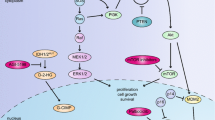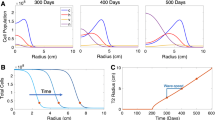Abstract
This chapter explores the use of mathematical models as promising and powerful tools to understand the complexity of tumors and their, frequently, hypoxic environment. We focus on gliomas, which are primary brain tumors derived from glial cells, mainly astrocytes and/or oligodendrocytes. A variety of mathematical models, based on ordinary and/or partial differential equations, have been developed both at the micro and macroscopic levels. The aim here is to describe in a quantitative way key physiopathological mechanisms relevant in these types of malignancies and to suggest optimal therapeutical strategies. More specifically, we consider novel therapies targeting thromboembolic phenomena to decrease cell invasion in high grade glioma or to delay the malignant transformation in low grade gliomas. This study has been the basis of a multidisciplinary collaboration involving, among others, neuro-oncologists, radiation oncologists, pathologists, cancer biologists, surgeons and mathematicians.
Access this chapter
Tax calculation will be finalised at checkout
Purchases are for personal use only
Similar content being viewed by others
References
Asghar W, El Assal R, Shafiee H, Pitteri S, Paulmurugan R, Demirci U (2015) Mater Today 18:539–553 [20pt]
Ayuso JM, Basheer HA, Monge R, Sánchez-Álvarez P, Doblaré M, Shnyder SD, Vinader V, Afarinkia K, Fernández LJ, Ochoa I (2015) Study of the chemotactic response of multicellular spheroids in a microfluidic device. PLoS One 10(10):e0139515
Ayuso JM, Monge R, Martínez-González A, Llamazares GA, Berganzo J, Hernández-Laín A, Santolaria J, Doblaré M, Hubert C, Rich JM, Sánchez-Gómez P, Pérez-García VM, Ochoa I, Fernández LJ (2016) Glioblastoma on a microfluidic chip: generating pseudopalisades and enhancing aggressiveness through thrombotic events. Neuro-oncology [20pt]
Badoual M, Gerin C, Deroulers C, Grammaticos B, Llitjos J-F, Oppenheim C, Varlet P (2014) Oedema-based model for diffuse low-grade gliomas: application to clinical cases under radiotherapy. Cell Prolif 47:369–380
Bastida E, Ordinas A, Escolar G, Jamieson GA (1984) Tissue factor in microvesicles shed from U87MG human glioblastoma cells induces coagulation, platelet aggregation, and thrombogenesis. Blood 64:177–184
Batchelor TT, Byrne TN (2006) Supportive care of brain tumor patients. Hematol Oncol Clin North Am 20:1337–1361
Bellail AC, Hunter SB, Brat DJ, Tan C, Van Meir EG (2004) Microregional extracellular matrix heterogeneity in brain modulates glioma cell invasion. Int J Biochem Cell Biol 36:1046–1069
Bogdanska MU, Bodnar M, Belmonte-Beitia J, Murek M, Schucht P, Beck J, Pérez-García VM (2016, submitted) A mathematical model of low grade gliomas treated with temozolomide and its therapeutical implications. Math Biosci
Brat DJ, Castellano-Sanchez AA, Hunter SB, Pecot M, Cohen C, Hammond EH, Devi SN, Kaur B, Van Meir EG (2004) Pseudopalisades in glioblastoma are hypoxic, express extracellular matrix proteases, and are formed by an actively migrating cell population. Cancer Res 64:920–927
Brat DJ, Van Meir EG (2004) Vaso-occlusive and prothrombotic mechanims associated with tumor hypoxia, necrosis, and accelerated growth in glioblastoma. Lab Invest 84:397–405
Candolfi M, Curtin JF, Stephen Nichols W, Muhammad AG, King GD, Elizabeth Pluhar G, McNiel EA, Ohlfest JR, Freese AB, Moore PF, Lerner J, Lowenstein PR, Castro MG (2007) Intracranial glioblastoma models in preclinical neuro-oncology: neuropathological characterization and tumor progression. J Neuro-Oncol 85:133–148
Elstner A, Holtkamp N, von Deimling A (2007) Involvement of Hif-1α in desferrioxamine-induced invasion of glioblastoma cells. Clin Exp Metastasis 24:57–66
Eltzschig HK, Carmeliet P (2011) Hypoxia and inflammation. N Engl J Med 364:656–665
Evans SM, Judy KD, Dunphy I, Jenkins WT, Hwang WT, Nelson PT, Lustig RA, Jenkins K, Magarelli DP, Hahn SM, Collins RA, Grady S, Koch CJ (2004) Hypoxia is important in the biology and aggression of human glial brain tumors. Clin Cancer Res 10:8177–8184
Furie B, Furie BC (2006) Cancer-associated thrombosis. Blood cells Mol Dis 36:177–181
Gatenby RA, Gillies RJ (2004) Why do cancers have high aerobic glycolysis? Nat Rev Cancer 4:891–899
Gerin C, Pallud J, Grammaticos B, Mandonnet E, Deroulers C, Varlet P, Capelle L, Taillandier L, Bauchet L, Duffau H, Badoual M (2012) Improving the time-machine: estimating date of birth of grade II gliomas. Cell Prolif 45:76–90
Giese A, Bjerkvig R, Berens ME, Westphal M (2003) Cost of migration: invasion of malignant gliomas and implications for treatment. J Clin Oncol 21:1624–1636
Gillies R, Gatenby R (2007) Hypoxia and adaptive landscapes in the evolution of carcinogenesis. Cancer Metastasis Rev 26:311–317
Green D, Kwaan HC (2009) Coagulation in cancer. Springer, New York/London
Hamilton MG, Hull RD, Pineo GF (1994) Prophylaxis of venous thromboembolism in brain tumor patients. J Neurooncol 22:111–126
Hanahan D, Weinberg RA (2011) Hallmarks of cancer: the next generation. Cell 144:646–674
Hardee ME, Zagzag D (2012) Mechanisms of glioma-associated neovascularization. Am J Pathol 181:1126–1141
Hatzikirou H, Basanta D, Simon M, Schaller K, Deutsch A (2012) “Go or Grow”: the key to the emergence of invasion in tumour progression. Math Med Biol 29:49–65
Horsman MR, Mortensen LS, Petersen JB, Busk M, Overgaard J (2012) Imaging hypoxia to improve radiotherapy outcome. Nat Rev Clin Oncol 9:674–687
Huse JT, Holland EC (2010) Targeting brain cancer: advances in the molecular pathology of malignant glioma and medulloblastoma. Nat Rev Cancer 10:319–331
Jenkins EO, Schiff D, Mackman N, Key NS (2010) Venous thromboembolism in malignant gliomas. J Thromb Haemost 8:221–227
Jensen RL (2009) Brain tumor hypoxia: tumorigenesis, angiogenesis, imaging, pseudoprogression, and as a therapeutic target. J Neurooncol 92:317–335
Joiner M, Van der Kogel A (2009) Basic clinical radiobiology, 4th edn. Hodder Arnold, London [20pt]
Keith B, Johnson RS, Simon MC (2012) HIF1α and HIF2α: sibling rivalry in hypoxic tumour growth and progression. Nat Rev Cancer 12:9–22
Keunen O, Fack F, Thorsen F, Taxt T, Bartos M, Jirik R, Miletic H, Wang J, Stieber D, Stuhr L, Moen I, Rygh CB, Bjerkvig R, Niclou SP (2011) Anti-VEGF treatment reduces blood supply and increases tumor cell invasion in glioblastoma. Proc Natl Acad Sci USA 108:3749–3754
Khorana AA, Francis CW (2008) Cancer associated thrombosis: new findings in translational science, prevention, and treatment. Informa Healthcare, New York
Li Z, Xu J, Zhang C, Liu X, Jiang L, Chen F (2013) Mammalian diaphanous-related formin 1 is required for motility and invadopodia formation in human U87 glioblastoma cells. Int J Mol Med 2:383–391
Louis DN, Ohgaki H, Wiestler OD, Cavenee WK (2007) World Health Organization classification of tumours of the central nervous system, 4th edn. Renouf Publishing Co. Ltd., Geneva
Martínez-González A, Calvo GF, Pérez Romasanta LA, Pérez-García VM (2012) Hypoxic cell waves around necrotic cores in glioblastoma: a biomathematical model and its therapeutic implications. Bull Math Biol 74:2875–2896
Martínez-González A, Durán-Prado M, Calvo GF, Alcaín FJ, Pérez-Romasanta LA, Pérez-García VM (2015) Combined therapies of antithrombotics and antioxidants delay in silico brain tumour progression. Math Med Biol 32:239–262
Onishi M, Ichikawa T, Kurozumi K, Date I (2011) Angiogenesis and invasion in glioma. Brain Tumor Pathol 28:13–24
Pardo R, Martínez-González A, Pérez-García VM (2016) Hypoxic ghost waves accelerates the progression of high-grade gliomas. Commun Nonlinear Sci Numer Simul 39:360–380
Pérez-García VM, Pérez-Romasanta L (2016) Extreme protraction for low-grade gliomas: theoretical proof of concept of a novel therapeutical strategy. Math Med Biol. doi:10.1093/imammb/dqv017
Pérez-García VM, Calvo GF, Belmonte-Beitia J, Diego D, Pérez-Romasanta L (2011). Bright solitary waves in malignant gliomas. Phys Rev E 84:021921
Pérez-García VM, Bogdanska M, Martínez-González A, Belmonte-Beitia J, Schucht P, Pérez-Romasanta L (2015) Delay effects in the response of low grade gliomas to radiotherapy: a mathematical model and its therapeutical implications. Math Med Biol 32:307–329
Perry JR, Julian JA, Laperriere NJ, Geerts W, Agnelli G, Rogers LR, Malkin MG, Sawaya R, Baker R, Falanga A, Parpia S, Finch T, Levine MN (2010) PRODIGE: a randomized placebo-controlled trial of dalteparin low-molecular-weight heparin thromboprophylaxis in patients with newly diagnosed malignant glioma. J Thromb Haemost 8:1959–1965
Planes A (2003) Review of bemiparin sodium: a new second-generation low molecular weight heparin and its applications in venous thromboembolism. Expert Opin Pharmacother 4:1551–1561
Pope WB, Young JR, Ellingson BM (2011) Advances in MRI assessment of gliomas and response to anti-VEGF therapy. Cur Neurol Neurosci Rep 11: 336–344
Rahman R, Smith A, Rahman C, Grundy R (2010) Antiangiogenic therapy and mechanisms of tumor resistance in malignant glioma. J Oncol 2010(251231):1–16
Ranalli NJ, Evans SM, Judy KD (2009) Hypoxia in brain tumors: a review of the literature. Neurosurg Quart 19:1–12
Robins H, ONeill A, Gilbert M, Olsen M, Sapiente R, Berkey B, Mehta M (2008) Effect of dalteparin and radiation on survival and thromboembolic events in glioblastoma multiforme: a phase II ECOG trial. Cancer Chemother Pharmacol 62:227–233
Rong Y, Post DE, Pieper RO, Durden DL, Van Meir EG, Brat DJ (2005) PTEN and hypoxia regulate tissue factor expression and plasma coagulation by glioblastoma. Cancer Res 65:1406–1413
Rong Y, Durden DL, Van Meir EG, Brat DJ (2006) ‘Pseudopalisading’ necrosis in glioblastoma: a familiar morphologic feature that links vascular pathology, hypoxia, and angiogenesis. J Neuropathol Exp Neurol 65:529–539
Schneider T, Mawrin C, Scherlach C, Skalej M, Firsching R (2010) Gliomas in adults. Deutsches Arzteblatt International 107:799–807
Simanek R, Vormittag R, Hassler M, Roessler K, Schwarz M, Zielinski C, Pabinger I, Marosi C (2007) Venous thromboembolism and survival in patients with high-grade glioma. Neuro-Oncol 9:89–95
Streiff MB, Segal J, Grossman SA, Kickler TS, Weir EG (2004) ABO blood group is a potent risk factor for venous thromboembolism in patients with malignant gliomas. Cancer 100:1717–1723
Svensson KJ, Kucharzewska P, Christianson HC, Sköld S, Löfstedt T, Johansson MC, Mörgelin M, Bengzon J, Ruf W, Belting M (2011) Hypoxia triggers a proangiogenic pathway involving cancer cell microvesicles and PAR-2-mediated heparin-binding EGF signaling in endothelial cells. Proc Nat Acad Sci 108:13147–13152
Swanson KR, Rostomily RC, Alvord EC Jr (2008) A mathematical modelling tool for predicting survival of individual patients following resection of glioblastoma: a proof of principle. Br J Cancer 98:113–119
Swanson KR, Rockne RC, Claridge J, Chaplain MA, Alvord EC Jr, Anderson AR (2011) Quantifying the role of angiogenesis in malignant progression of gliomas: in silico modeling integrates imaging and histology. Cancer Res 71:7366–7375
Wilson WR, Hay MP (2011) Targeting hypoxia in cancer therapy. Nat Rev Cancer 11:393–410
Wouters A, Pauwels B, Lardon F, Vermorken J (2007) Implications of in vitro research on the effect of radiotherapy and chemotherapy under hypoxic conditions. The Oncologist 12:690–712
Xu X, Farach-Carson MC, Jia X (2014) Three-dimensional in vitro tumor models for cancer research and drug evaluation. Biotechnol Adv 32(7):1256–1268
Young A, Chapman O, Connor C, Poole C, Rose P, Kakkar AK (2012) Thrombosis and cancer. Nat Rev Clin Oncol 9:437–449
Zagzag D, Zhong H, Scalzitti JM, Laughner E, Simons JW, Semenza GL (2000) Expression of hypoxia-inducible factor 1α in brain tumors: association with angiogenesis, invasion, and progression. Cancer 88:2606–2618
Zwicker JI, Furie BC, Furie B (2007) Cancer-associated thrombosis. Clin Rev Oncol Hematol 62:126–136
Acknowledgements
The work of the Mathematical Oncology Laboratory (MôLAB) on the mathematical modelling of the glioma microenvironment and its therapeutical implications is supported by: University of Castilla-La Mancha; Junta de Comunidades de Castilla-La Mancha, Spain (grant number PEII-2014-031-P); Ministerio de Economía y Competitividad/FEDER, Spain (grant numbers: MTM2012-31073 and MTM2015-71200-R); and James S. Mc. Donnell Foundation twenty-first Century Science Initiative in Mathematical and Complex Systems Approaches for Brain Cancer (Special Initiative Collaborative-Planning Grant 220020420 and Collaborative award 220020450). We would like to thank the Pathology Department from Hospital General Universitario de Ciudad Real (Spain) for providing some of the histopathological images and to Dr. Marcial García Rojo from the Pathology Department at Hospital de Jerez de la Frontera, (Spain) for helpful discussions.
Author information
Authors and Affiliations
Corresponding author
Editor information
Editors and Affiliations
Rights and permissions
Copyright information
© 2016 Springer International Publishing Switzerland
About this chapter
Cite this chapter
Martı́nez-González, A., Calvo, G.F., Ayuso, J.M., Ochoa, I., Fernández, L.J., Pérez-García, V.M. (2016). Hypoxia in Gliomas: Opening Therapeutical Opportunities Using a Mathematical-Based Approach. In: Rejniak, K. (eds) Systems Biology of Tumor Microenvironment. Advances in Experimental Medicine and Biology, vol 936. Springer, Cham. https://doi.org/10.1007/978-3-319-42023-3_2
Download citation
DOI: https://doi.org/10.1007/978-3-319-42023-3_2
Published:
Publisher Name: Springer, Cham
Print ISBN: 978-3-319-42021-9
Online ISBN: 978-3-319-42023-3
eBook Packages: Biomedical and Life SciencesBiomedical and Life Sciences (R0)




